Deterring Woodpeckers from Damaging Cedar Siding
Published April 4, 2024 at 8:20 pm
Learn how to effectively prevent woodpeckers from damaging your cedar siding with humane deterrent techniques and proven strategies for protecting your home’s exterior.

“`html
Understanding Cedar Siding and Woodpecker Attractions
If you're noticing holes and damage to your cedar siding, it's possible woodpeckers are the culprits. These birds are often drawn to houses with cedar siding because of insects living within the wood or as a method to communicate with other woodpeckers. Knowing why woodpeckers might favor your siding is the first step in deterring them.
Woodpeckers peck for several reasons, including searching for food, creating nesting sites, and even territorial drumming. Cedar, being a softer wood, can become a target due to its ease of penetration and the potential for insects to reside within.
Preventative Measures to Protect Cedar Siding
Bird-proofing your home can be as much about prevention as it is about deterrence. Regularly inspecting your cedar siding for signs of insect infestation and treating the wood can make your home less appealing to these persistent birds.
Applying insect repellent or having a professional exterminator treat your home can be a vital step. Preventing insects from making your siding their home keeps the woodpeckers at bay, as they are often attracted to the sounds of insects inside the wood.
Effective Deterrence Strategies
Woodpeckers are protected under the Migratory Bird Treaty Act, so it's essential to use humane and non-lethal methods for deterrence. Reflective objects, like aluminum foil strips or reflective tape, can serve as an effective deterrent when hung near affected areas.
Another method is the installation of physical barriers, such as netting, which prevents woodpeckers from accessing the siding. These methods should be employed carefully to ensure they do not harm the birds or detract significantly from your home's appearance.
Combining Visual and Auditory Tactics
Combining visual scares with unexpected auditory noises can be a powerful way to keep woodpeckers away. Devices that produce noise, like ultrasonic bird repellents or those that mimic predator sounds, can be strategically placed to create an unwelcoming environment for woodpeckers.
Visual deterrents such as fake owls or snake decoys can also be helpful but need to be moved regularly to prevent the woodpeckers from realizing these are not living predators. The combination of sight and sound helps to simulate a dangerous environment, encouraging woodpeckers to find safer places to peck.
Applying Woodpecker Repellents
When looking at repellents, consider products like bird stop or woodpecker deterrent sprays. These products often contain a bittering agent that discourages pecking by making the wood unpalatable to birds. Be sure to follow the manufacturer's instructions carefully when applying these products.
One such repellent is Bird-B-Gone Woodpecker Deterrent Spray. It's claimed that this product creates an invisible barrier that irritates woodpeckers' senses, making treated surfaces unpleasant for them. Reviewers often mention its ease of use and the fact that it does not harm the birds but still manages to keep them at bay with consistent application.
Find This and More on Amazon
“““html
Natural Home Remedies for Woodpecker Deterrence
You may also want to explore natural, DIY solutions for deterring woodpeckers. This could involve using common household items to create an unwelcoming environment for the birds.
For instance, hanging pie tins or CDs that move in the wind and reflect sunlight can startle and dissuade woodpeckers. Similarly, setting up a string of chili peppers is a method some homeowners swear by, as the capsaicin is a natural bird repellent.
Maintaining Your Siding for Long-term Protection
Keeping your cedar siding in top shape is crucial for preventing woodpecker damage. Regular maintenance, such as sealing or painting the wood, can not only make it less appealing to pests but can also reduce the acoustic resonance that attracts woodpeckers.
For those who've already noticed damage, it's important to repair any holes or imperfections promptly to avoid further attraction. Filling smaller holes with wood putty and covering larger areas with metal sheathing or a woodpecker-specific patch can minimize ongoing issues.
Understanding Woodpecker Behavior to Outsmart Them
Woodpeckers follow certain behavioral patterns, which, if understood, can help you in your efforts to deter them. They are attracted to sounds that resonate, which might explain why they target certain areas of your siding over others.
By altering the surface or density of the cedar, such as using a denser paint or even applying a soft padding under siding sections, you might reduce the resonating surface that woodpeckers find so appealing.
Building Woodpecker Boxes: A Humane Alternative
Providing an alternative pecking space could redirect woodpecker behavior away from your siding. Building or purchasing a woodpecker box and installing it in a quiet area of your yard can encourage the birds to claim that space instead.
Make sure the box is built from untreated wood, and place it in a shaded spot to emulate the natural nesting environment. This approach not only solves your problem, but also supports the local wildlife ecosystem.
Professional Assessment and Solutions
When DIY methods and over-the-counter products don't seem to work, it might be time to call in the professionals. Wildlife control services can offer specialized approaches and techniques that are compliant with local and federal wildlife laws.
Experts can assess the situation to determine why woodpeckers are attracted to your home and implement tailored solutions that ensure long-term results. They may also offer repair services for the damage that has been done.
Keeping Track of Damage and Deterrent Success
It's helpful to keep a log of when and where you notice woodpecker damage, as well as the methods of deterrence you've tried. This documentation can help you identify patterns and make more informed decisions about which deterrent strategies are most effective for your home.
Additionally, sharing this information with neighbors can be beneficial, as woodpeckers may move from one house to another. Collective neighborhood efforts can be more successful in deterring woodpeckers over larger areas.
Incorporating Landscaping to Your Advantage
The landscaping around your home can play a significant role in attracting or repelling woodpeckers. Certain trees or shrubs might be more appealing to these birds and by strategically designing your garden, you might be able to keep them at a comfortable distance from your siding.
Consulting with a landscaping expert may provide insights into plant species that are less attractive to woodpeckers. Additionally, ensuring that your garden is tidy and free from insect infestations will further reduce the likelihood of woodpecker visits.
Final Thoughts on Protecting Your Cedar Siding from Woodpeckers
Protecting your cedar siding from woodpecker damage requires a combination of strategies that address both the immediate issue and the underlying attractions. It's all about balance – creating an environment that is less appealing to woodpeckers while not causing them harm and keeping your home looking beautiful.
Whether you're applying physical deterrents, using repellents, making home improvements, engaging with professional services, or offering alternative nesting sites, you have a variety of options to help preserve the integrity of your cedar siding. Regularly maintaining your home and remaining vigilant about changes in woodpecker activity are key to success.
“““html
Conduct Regular Inspections and Timely Repairs
To mitigate the risk of woodpecker damage, ensure that your cedar siding undergoes periodic inspections. Look out for any early signs of pecking or drilling, and address them immediately to prevent more extensive damage.
Timely repairs to your cedar siding can discourage woodpeckers from returning to the same spot. If they find that their efforts yield no result or their preferred spot is continually disrupted, they’re more likely to move on to other areas.
Repelling Woodpeckers with Scents and Tastes
Beyond visual and physical deterrents, certain scents and tastes can act as effective woodpecker repellents. Consider products that use strong smells or flavors woodpeckers dislike, such as garlic-based sprays or non-toxic, bitter-tasting compounds.
Regularly applying these products to your cedar siding can make it unattractive to woodpeckers without causing them harm. One such product getting attention is the Bird-X 4 The Birds Repellent Liquid. Users have mentioned its lasting effectiveness and the convenience of its application, although some have noted the scent can be quite intense upon initial use.
Find This and More on Amazon
Utilizing Technology for Long-Term Deterrence
Advances in technology offer new solutions for woodpecker deterrence, such as motion-activated sprinklers or sonic deterrents that activate when woodpecker activity is detected. These devices can be set up to protect high-risk zones of your siding.
While some homeowners have found success with these high-tech methods, it is essential to monitor their effectiveness, as woodpeckers can sometimes grow accustomed to the patterns of these devices. Being adaptable and ready to try different technologies can lead to more successful outcomes.
Understanding the Migratory Bird Treaty Act
When implementing any measures to prevent woodpecker damage, it is crucial to be aware of the Migratory Bird Treaty Act, which protects woodpeckers and other birds. Ensure that your deterrent methods are non-lethal and compliant with federal regulations to avoid any legal repercussions.
For instance, it’s advisable not just to focus on enhancing indoor air quality with peace lilies or the perfect care for a thriving alocasia, but also to ensure your garden and home exteriors are safe and hospitable environments for local wildlife.
Social Proof and Community Involvement
Engaging with neighbors to share strategies and successes can provide a wealth of knowledge and lead to a cohesive approach in deterring woodpeckers. Community forums and local wildlife groups are excellent resources to exchange information.
Neighbors may have tried different solutions like those shared on how to create a pollinator-friendly vegetable garden, which would not only attract bees and butterflies but also might inadvertently protect your cedar siding by offering alternative pecking sites for woodpeckers.
When to Consider Replacement of Cedar Siding
Even with diligent efforts to deter woodpeckers, there may come a time when the damage to your cedar siding is too extensive, and replacement becomes a more cost-effective option. Modern alternatives to cedar might offer improved resistance to woodpecker damage.
Evaluating the costs and benefits of different siding materials can be a wise long-term investment. Fiber cement siding, for example, has gained popularity for its durability and woodpecker resistance, potentially saving you from frequent repairs or deterrent strategies.
Custom Tailoring Solutions for Your Home
Remember that each home is unique, and what works for one may not work for another. It’s important to tailor your woodpecker deterrence strategies to the specific needs of your home and to remain flexible in trying different solutions.
Whether you’re combining multiple deterrent methods, opting for professional help, or exploring technological solutions, the aim is to protect your cedar siding effectively while coexisting peacefully with local wildlife.
“`
Shop more on Amazon
Flowers & Plants Team
Flowers & Plants Team


